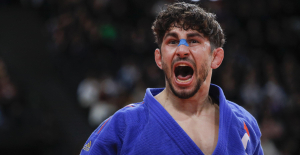Hyenas are howling somewhere in the bush. The Southern Cross can be seen in the sky. It's the first night of my life that I sleep without a roof over my head. Sometimes it cracks in the thicket without being able to identify the cause. I'm lying on my sleeping pad, a campfire is burning a few meters away, and there's a tree above my head. I keep waking up and looking up. I'm afraid a leopard might be sitting on top. That's the thing with adventure, when you're in the thick of it and can't run away.
I am part of a special hiking group. We want to embark on a different kind of safari for four days and three nights: on foot through the bush, without an off-road vehicle. The first night only equipped with a protective tarpaulin, sleeping pad and sleeping bag under the open sky, later in the tent.
It goes through the Babanango Nature Reserve in the province of Kwazulu-Natal in eastern South Africa. Our group consists of five men and one woman. In addition to two guides, there are: Andrew Baxter, head of the company that owns the Babanango Game Reserve. Gaby Pabst, managing director of a Cape Town travel agency. Gordon Laing, a sustainability consultant. And me.
Our trekking tour is the first guided multi-day trek through the Babanango wilderness. Leopards, zebras, hippos, buffaloes, giraffes, impalas and rhinos have lived here so far. During these weeks, elephants and lions will be added, which have been resettled from other regions of South Africa and have lived here before.
It is a pioneering journey that no one has done before. One that causes tingling in the stomach even before the start of the tour. Even if you don't usually get as close to the animals as you would in a jeep. They are shy, the guides say, and avoid human contact. To see them you have to sneak up on them and you need binoculars or a good camera.
One of the guides is Hendrik Fehsenberg, a South African of German descent. He looks like Crocodile Dundee: wide-brimmed hat, safari clothes that have earned their mark in the bush. He distributes freshly cut hiking sticks to the participants and cuts them to the right length with his pocket knife. He will lead the group together with his colleague Bongani Khumalo.
Trail walking is what trekking safaris in South Africa call themselves. The exciting thing about our special hike: There is no trail yet, i.e. no hiking trail. It has to be found first and will only come about when groups regularly go the route.
Although there will be no fixed path, nature should look the same after the tour as before. The bush here was once farmland. In the meantime it has been largely renatured. The reserve is 19,250 hectares, about 26,000 soccer fields.
Packing is done together before the start of the tour. Fehsenberg and company boss Baxter are professionals. They warn that if you pack too heavy, you won't be able to do the tour. "We run through difficult terrain," says the tall Fehsenberg. "Everyone has to carry their own food plus part of the communal catering." Everything that is superfluous stays in the lodge. For me it is: the heavy telephoto lens, the second pair of hiking pants, another pair of shoes.
We start in the morning, after two hours we are at the White Mfolozi River. It runs through the hills like a silver ribbon. We have to go through this. Pants are rolled up to above the knees, hiking boots are hanging on the stick across both shoulders. Caution is advised: the river bed collapses waist-deep in some places, the stones are slippery. The backpacks don't make things any easier. Gaby Pabst slips and lands lengthways in the river. She gets up again, laughs.
Pabst knows what she got herself into. It is not the first tour for the South African. She says that just a few weeks earlier she hiked the 41-kilometer Otter Trail on South Africa's Garden Route. Steep up, then steep down. There too with sleeping in the open air.
The Otter Coastal Path can only be compared to our trekking tour to a limited extent - there is no signposted path here, but through the bush with dense undergrowth, without a path. Thorns of four or five centimeters at the level of the arms, the chest, the face. It is the territory of wild animals that hunt here.
Going to the toilet is naturally rustic: into the bushes, dig a hole, do business and fill it up again. Fehsenberg advises that it would be even better to pull a larger rock out of the ground and use the hole. But beware, there are poisonous snakes here! I decide to keep my needs to a minimum.
Hours after crossing the river, we reach a slab of rock above the river, nestled between bushes and a creek. The evening sun warms up the rocks a bit. Khumalo discovers footprints on the shore. Fehsenberg kneels, looks at her: a leopard. "They're not old yet." Maybe from the morning.
The two trackers are looking for firewood to cook dinner. And also to keep the big cat away from the sleeping place at night. Khumalo cooks a kind of goulash out of meat, tomatoes and onions. He tells about the Zulu kings, their wars, the cemeteries nearby. your kingdom.
Our guides lie directly by the fire on the rock slab. Everyone else unrolls their protective tarps on the soft grass nearby, blows up their sleeping pads and puts their sleeping bags over them. "Once the lions and elephants have settled into the reserve, we'll have to collect even more wood," says Fehsenberg. "Everyone then has to sleep very close to the fire." For safety reasons.
Normally humans are not prey for lions. But safe is safe. The guides will then also be armed with guns. On our tour they are not, because there are no elephants and lions on the road yet. If Fehsenberg didn't inspire a lot of confidence in me, the unarmed guides would have worried me. At night in the bush, imagination can play tricks, as described in the opening scene.
Before the start of the tour, sustainability consultant Gordon Laing poured a 50-year-old port wine into a plastic bottle. There is a small glass for everyone. "You have to be really warm," advises Baxter. "The sleeping bag keeps you warm, but it doesn't warm you up."
Day 2. Just after six o'clock the sun breaks through the treetops of Babanango. It is icy at night and in the morning in the South African winter. For breakfast there is muesli with dried milk, apples and energy bars. Fehsenberg hands out hot coffee.
Actually, I just want to fill up the drinking bottles for myself and the others in the stream next to the camp. I stand with my legs apart on two large stones in the middle of the water, bend down, slide – and fall into the trickle. Pants and shoes are wet, the change of clothes in the lodge.
What the hell. With a backpack weighing almost 20 kilograms, you warm up quickly. Less than fifteen minutes later, Khumalo discovers a new track. Fehsenberg pushes his hat back: "The leopard hunted here in the night." He shows where the animal dragged its victim up the slope, how the latter dug its hooves into the ground. Remains of fur and meat, however, cannot be seen.
It will be a long day. The undergrowth is dense. No one goes ahead with a machete chopping off branches on this trip. "These migrations are supposed to take place in such a way that nobody who comes after us will see that we were here," explains Baxter. Fehsenberg and Khumalo had already cleaned away the remains of ashes from the rock slab with sand and water at the night camp.
The average speed until noon is one kilometer per hour. The terrain is difficult. We only arrive at our destination at sunset. It wasn't much more than 13 kilometers. Still, everyone is tired. "If we offer the tours more often in the future, we will have to halve the distance," believes Baxter.
The new camp site is surrounded by hills. They glow golden in the light of the evening sun. We still need wood for the fire – and water. The bottles are empty. The operators of the Babanango Game Reserve have put down tents on site. But they are not constructed. We want to sleep under the open sky again.
Fehsenberg tells that there is water below the camp and how he found it: "Put your hands behind your ears like shells," he says and demonstrates it. You can actually hear the water rushing. Later, the body of water turns out to be a brook. It's enough for the bottles.
There is coffee, sausages and marshmallows by the fire. Gordon Laing pulls out another plastic bottle, this time filled with a honey-colored liquid: a Macallan single malt whiskey. Chris Galliers, President of the global ranger organization Galliers, has joined us for the night in the 4x4.
He knows everything about reserves, poachers and costs. African national parks spend many times what the European competition pays for security: "The reason for this are poachers." Rhino horn in particular is popular in Asia as an aphrodisiac. The buyers in China paid such high sums that the animals are difficult to protect.
The parks are therefore fenced off with barbed wire. Armed squads patrol the vast grounds. There are motion detectors and controls at the entrances. Despite this, 451 of these animals were killed in 2021 in South Africa alone. Some reserves, such as the Babanango Game Reserve, stun their rhinos regularly and then cut their horns short so that the animals are of no interest to poachers. You certainly don't experience something like this in passing on a trekking safari.
Around 7 p.m. rain breaks out. We set up the tents in no time at all, lug everything that is outside inside, and split up. There is no electricity on the tour and therefore no light, so you can sleep right away. If it weren't for the neighbor in the tent. He snores so loudly that you could develop a lust for murder.
Then suddenly there is a crack next to the tent. The sounds get louder and louder, as if something heavy is trampling on dry wood. I hold onto my flashlight in case animal guests come into the tent. I don't fall asleep for hours. Luckily there are no uninvited visitors.
Shortly after five o'clock the night is already over. Before breakfast we climb a small mountain opposite Zulu Rock. The White Mfolozi River meanders silver through the valley. The area is green-brown. The sun climbs over the Babanango Mountains.
"Did you hear the noise in the night?" Fehsenberg asks at breakfast. Someone snored so loudly that he collected branches again and fanned the fire in the hope that the snorer would be bothered by it. A pious wish.
The third day should bring us to the goal of the tour. After all the trouble, a surprise is promised at the end. We are excited. Toilet, shower, bed?
During the day it is pleasant. The weather is not too cold, the route is only slightly uphill through waist-high grass. "That's the north side," says Fehsenberg, looking carefully into the deep grass: "Be careful about snakes." From then on, I follow in his footsteps. I keep pushing the grass aside with the stick. We don't see a snake during the hike, but we do see a snake skin.
The last climb of the day will be long. Then we are in for a surprise. Tables with white cloths are set up on the hill. Behind them you can see three large tents. Reserve staff offer drinks. There should also be hot food. In the tents there are folding beds with thick blankets and hot-water bottles underneath.
"Well, that's what I call luxury," says Baxter with a grin. Unfortunately we don't have any of that. A storm breaks out of the blue, thunder and lightning. The wind tears at the tents. It's pouring with rain. We save ourselves in the tents, then it's time to wait. As soon as the first storm is over, the next one approaches.
The evening literally falls into the water, the tour has to be canceled one night earlier. We are rushed from the mountain to the lodge in an off-road vehicle. The big car can hardly handle the soggy terrain. It slides towards the slope. But Fehsenberg keeps track and catches it again.
We breathe a sigh of relief when we reach the lodge. In addition to good food, there is finally a real bed there. It doesn't have to be too much adventure.
Trekking safaris are offered in South Africa, Namibia, Tanzania and Botswana, among others. Multi-day trail walking is often combined with other highlights in the country, such as a swim. Prices vary depending on the destination.
Pioneer Trail in the Gondwana Game Reserve, South Africa: A two-day hike with an overnight stay in a tent with a double bed costs 730 euros per person (gondwanagr.co.za).
Explorer Camp in the Shamwari Game Reserve, South Africa: Two nights in a safari tent as a fixed base for hikes that start from there cost from 560 euros per person and tent night (shamwari.com).
Babanango Game Reserve: Four-day hikes with three overnight stays cost around 330 euros per person. The minimum number of participants is four people. A three-day hike with two overnight stays costs from 265 euros per person. You sleep under the stars or in light tents, the tours are accompanied by armed guides. An overnight stay before the start of the tour and after it ends in the lodges of the reserve costs between 165 and 550 euros, depending on the standard (babanango.co.za).
General information about South Africa: southafrica.net/de/de/travel
Participation in the trip was supported by Babanango Game Reserve. You can find our standards of transparency and journalistic independence at axelspringer.com/de/Werte/downloads.

 Hamas-Israel war: US begins construction of pier in Gaza
Hamas-Israel war: US begins construction of pier in Gaza Israel prepares to attack Rafah
Israel prepares to attack Rafah Indifference in European capitals, after Emmanuel Macron's speech at the Sorbonne
Indifference in European capitals, after Emmanuel Macron's speech at the Sorbonne Spain: what is Manos Limpias, the pseudo-union which denounced the wife of Pedro Sánchez?
Spain: what is Manos Limpias, the pseudo-union which denounced the wife of Pedro Sánchez? Spain is the country in the European Union with the most overqualified workers for their jobs
Spain is the country in the European Union with the most overqualified workers for their jobs Parvovirus alert, the “fifth disease” of children which has already caused the death of five babies in 2024
Parvovirus alert, the “fifth disease” of children which has already caused the death of five babies in 2024 Colorectal cancer: what to watch out for in those under 50
Colorectal cancer: what to watch out for in those under 50 H5N1 virus: traces detected in pasteurized milk in the United States
H5N1 virus: traces detected in pasteurized milk in the United States Private clinics announce a strike with “total suspension” of their activities, including emergencies, from June 3 to 5
Private clinics announce a strike with “total suspension” of their activities, including emergencies, from June 3 to 5 The Lagardère group wants to accentuate “synergies” with Vivendi, its new owner
The Lagardère group wants to accentuate “synergies” with Vivendi, its new owner The iconic tennis video game “Top Spin” returns after 13 years of absence
The iconic tennis video game “Top Spin” returns after 13 years of absence Three Stellantis automobile factories shut down due to supplier strike
Three Stellantis automobile factories shut down due to supplier strike A pre-Roman necropolis discovered in Italy during archaeological excavations
A pre-Roman necropolis discovered in Italy during archaeological excavations Searches in Guadeloupe for an investigation into the memorial dedicated to the history of slavery
Searches in Guadeloupe for an investigation into the memorial dedicated to the history of slavery Aya Nakamura in Olympic form a few hours before the Flames ceremony
Aya Nakamura in Olympic form a few hours before the Flames ceremony Psychiatrist Raphaël Gaillard elected to the French Academy
Psychiatrist Raphaël Gaillard elected to the French Academy Skoda Kodiaq 2024: a 'beast' plug-in hybrid SUV
Skoda Kodiaq 2024: a 'beast' plug-in hybrid SUV Tesla launches a new Model Y with 600 km of autonomy at a "more accessible price"
Tesla launches a new Model Y with 600 km of autonomy at a "more accessible price" The 10 best-selling cars in March 2024 in Spain: sales fall due to Easter
The 10 best-selling cars in March 2024 in Spain: sales fall due to Easter A private jet company buys more than 100 flying cars
A private jet company buys more than 100 flying cars This is how housing prices have changed in Spain in the last decade
This is how housing prices have changed in Spain in the last decade The home mortgage firm drops 10% in January and interest soars to 3.46%
The home mortgage firm drops 10% in January and interest soars to 3.46% The jewel of the Rocío de Nagüeles urbanization: a dream villa in Marbella
The jewel of the Rocío de Nagüeles urbanization: a dream villa in Marbella Rental prices grow by 7.3% in February: where does it go up and where does it go down?
Rental prices grow by 7.3% in February: where does it go up and where does it go down? “Deadly Europe”, “economic decline”, immigration… What to remember from Emmanuel Macron’s speech at the Sorbonne
“Deadly Europe”, “economic decline”, immigration… What to remember from Emmanuel Macron’s speech at the Sorbonne Sale of Biogaran: The Republicans write to Emmanuel Macron
Sale of Biogaran: The Republicans write to Emmanuel Macron Europeans: “All those who claim that we don’t need Europe are liars”, criticizes Bayrou
Europeans: “All those who claim that we don’t need Europe are liars”, criticizes Bayrou With the promise of a “real burst of authority”, Gabriel Attal provokes the ire of the opposition
With the promise of a “real burst of authority”, Gabriel Attal provokes the ire of the opposition These French cities that will boycott the World Cup in Qatar
These French cities that will boycott the World Cup in Qatar Judo: Blandine Pont European vice-champion
Judo: Blandine Pont European vice-champion Swimming: World Anti-Doping Agency appoints independent prosecutor in Chinese doping case
Swimming: World Anti-Doping Agency appoints independent prosecutor in Chinese doping case Water polo: everything you need to know about this sport
Water polo: everything you need to know about this sport Judo: Cédric Revol on the 3rd step of the European podium
Judo: Cédric Revol on the 3rd step of the European podium


















